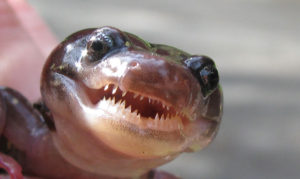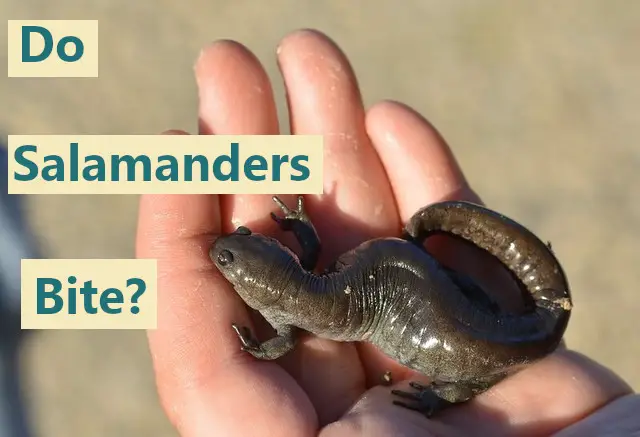Salamanders are intriguing creatures and are relatively easy to care for. This makes them a popular pet among amphibian enthusiasts. Should you ever be worried about being bitten by a salamander?
Salamanders are known to bite. However, you shouldn’t be too worried about being bitten by a salamander, because they are very docile creatures that will rarely intentionally bite a human.
The only time a salamander may bite is during aggressive feeding when it mistakes your hand or finger for food, or when it is being handled in a way that makes it uncomfortable and causes it stress.
A Bite From a Salamander Is Usually Nothing to Be Worried About
Salamanders do not like to be handled by humans (or anything bigger than them), so they will understandably bite when they feel threatened.
However, they are generally not aggressive creatures, and their first reaction to danger will be to run and hide. A salamander will only bite as a last attempt to defend itself.
Most Salamanders Only Have Tiny Teeth
Over 90% of salamander species only have tiny teeth in both their lower and upper jaws. Unlike most amphibians, even larval stage salamanders have these teeth.
The teeth of the larvae usually have a conical shape, while those of adults are adapted to efficiently grip prey.

Salamanders do not use their teeth to chew their food. Rather, they use them to maintain a tight grip on their prey as they swallow it whole.
Arboreal Salamanders Can Deliver a Painful Bite
Although most salamanders do bite, the severity of the bite varies greatly between species. As a general rule, the larger the salamander, the stronger its jaws will be and the stronger its bite.
For example, a large tiger salamander will have a much stronger bite than a tiny red-backed salamander.
However, this isn’t always the case. Arboreal salamanders (a type of tree-climbing salamander) have well-developed sharp teeth that are very large in proportion to the rest of their body. They also have very strong jaws and are capable of delivering a painful bite that can draw blood.

Male arboreal salamanders have broad triangular heads that can exert a stronger bite force – and teeth that are typically larger than those of females.
These salamanders are native to California and Baja California where they are often found on mossy rocks, and inside tree stumps in oak woodlands.
However, bites from arboreal salamanders are quite rare, because these salamanders are very reclusive and are not frequently encountered by humans.
Also, they are generally very cautious and will escape if they see you approach. They only bite to defend themselves.
Other Salamanders That Are Known for Biting
Tiger salamander – Tiger salamanders are one of the largest terrestrial salamanders in the world. They can grow to over 12 inches and are a popular pet.
If a Tiger salamander bites your finger, it may feel like putting a clothespin on your finger and may give you a freight. But will most likely not cause any real harm.
Mudpuppy – Mudpuppies are fully aquatic salamanders found in many parts of the United States. They have feathery gill and a flat paddle-like tail for their life in the water. These salamanders rarely bite, and when they do, the bite usually does not cause any serious harm.
However, a misconception that Mudpuppies have a venomous bite or stinger has led to them being killed when caught on fishing lines or fishing nets. Partly due to this, Mudpuppies are considered at-risk in 13 US states.
Hellbender – Hellbenders are the largest salamanders in the United States. These salamanders are fully aquatic and are often confused for mudpuppies.
An easy way to tell a hellbender from a mudpuppy is that; mudpuppies have external feathery gills, while the hellbender doesn’t.
Hellbenders are generally not aggressive to humans, and will rarely even put up a fight when handled. However, their odd appearance has given rise to several myths about these salamanders, one being that they have a venomous bite. This myth is untrue.
Hellbenders will only bite if they feel threatened. A bite from a hellbender is usually nothing to be too concerned about, as it is not venomous and is unlikely to cause any serious harm.
What to Do if You Get Bitten by a Salamander
In the rare event that you get bitten by a salamander, you should take a few precautions to protect both you and the animal.
Salamanders will typically let go shortly after biting. However, there are cases in which a salamander will bite and clamp on for an extended period. Should this happen,
- Use your other fingers to slowly push it off your finger.
Be gentle and do it close to the ground, so you don’t hurt the salamander in the process.
Once the salamander releases;
- Carefully inspect the bite area for any blood or breaks in the skin.
- Very thoroughly wash the bite area with anti-bacterial soap to prevent any infection
Just this will be sufficient for most salamander bites. However, in the rare situation that the bite causes serious damage, it is advisable to seek medical attention.
More Toxin, Less Bite
Although salamanders can bite, they will only intentionally do so as a last resort. Most salamanders have other, more effective ways of defending themselves.
As the first line of defense, most salamanders will simply dash for cover to escape the threat. Once in cover, they will stay still to hide from the attacker.
As an added layer of defense, many salamanders produce milky toxins from special glands in their bodies and secrete these toxins all over their skin.
The toxins make the salamander taste bad to any predator that tries to eat it, and can sometimes even be lethal.
Salamanders will only bite in the last-ditch attempt to defend themselves if their other defenses do not do the job.
Can You Get Poisoned by a Bite From a Salamander?
Although most salamanders are poisonous, their bites are not venomous. Confused? Well, this is most likely due to a misunderstanding of the terms “venomous” and “poisonous”.
If you are like most people, you use these two terms interchangeably. You may see a snake and call it poisonous, or a frog and call it venomous. However, you should know that there are major differences between these two concepts.
Generally,
- Venom is delivered into a wound
- Poison is inhaled or absorbed into the body
This means a venomous animal will actively inject its toxin into your body, usually through fangs, stings, or barbs.
A poisonous animal on the other hand delivers its toxin more passively, usually coating its skin with the toxin. The toxin is then absorbed by any animal (or human), that touches or tries to eat it.

In this way, rattlesnakes, scorpions, and many spiders are venomous, while poison dart frogs, newts, and salamanders are poisonous.
Since salamanders secrete their toxin on their skin, their bites are not venomous, and not harmful in any serious way.
What About Venomous Salamanders?
Salamanders are often informally divided into two groups. Newts and “true salamanders”.
True salamanders are only poisonous without any ability to inject their toxin, however, several newts, such as the Spanish ribbed newt can actively inject their toxin. This means they are technically venomous.
These newts have sharp ribs, which they push through tubercles running down the sides of their body. These ribs then “sting” the attacker and inject the toxin in the process.
Since these toxins aren’t delivered via teeth, a bite from a venomous newt will be as harmless as a bite from any other salamander.
Frequently Asked Questions
Question: Are Salamanders Dangerous?
Answer: Salamanders are generally harmless creatures when left alone. The only danger comes when you handle them and ingest their toxins (or bacteria) due to poor hygiene and/or poor safety precautions.
If you ever need to handle a salamander, be sure to take precautions to ensure the safety of both you and the salamander.
Question: Can a Salamander Kill You?
Answer: Yes, a salamander can certainly kill you, but only if you lick or swallow it. Merely touching one will not kill you because the toxins it secretes are most effective when ingested in large quantities.
Also, salamanders and other amphibians carry salmonella and other bacteria that are harmful to humans. So, eating or licking a salamander will not only expose you to its toxins but may also expose you to bacteria that can make you seriously ill.
Conclusion
Salamanders are very shy creatures that are usually harmless to humans. Understandably, they sometimes feel threatened when handled by a human and bite to defend themselves. A bite from a salamander is completely harmless, and in most cases won’t even require any sort of medical attention.
Photo credit: Andy Reago & Chrissy McClarren/flicker


